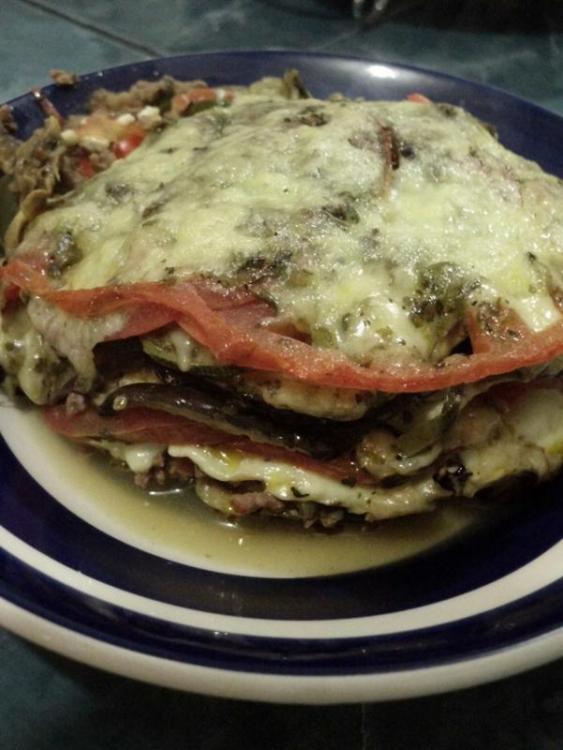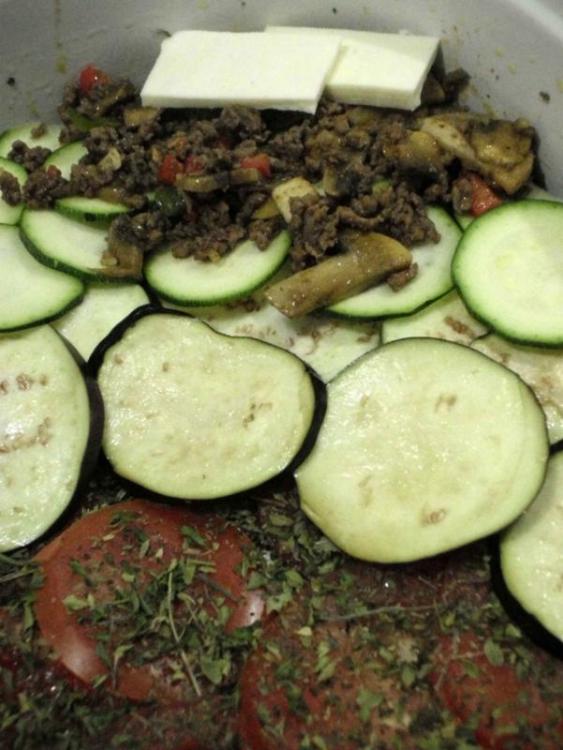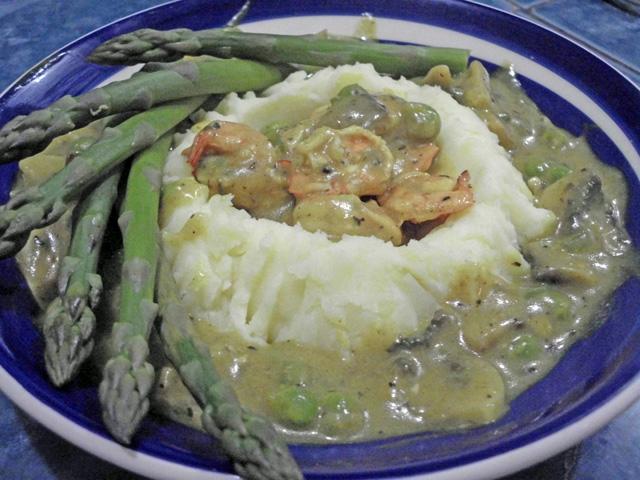-
Posts
2,383 -
Joined
-
Last visited
Content Type
Profiles
Forums
Store
Help Articles
Everything posted by Panaderia Canadiense
-

Finding Butter Tarts in Seattle
Panaderia Canadiense replied to a topic in Pacific Northwest & Alaska: Cooking & Baking
Why not make them yourself? They're incredibly simple, particularly if you've got access to premade puff pastry.... -
I think the flavour thing might be more evident on vine-ripened and picked at peak vs. picked-green and gas-ripened passionfruits. What I've found with Maracuyá is that the greener or less ripe naturally the fruits are, the yellower the pulp is and the more acidic the flavour. A vine-ripe, properly mature Maracuyá has an intense floral scent, bright orange pulp, and is subtly sweeter than a green one. Of course, I can only tell you this because of my "scientific" method of scarfing multiple examples, both ripe and green, whenever the opportunity presents itself....
-
Thanks! I've now got three purply-green guys sitting in the fruit bowl... I just hope they don't do that Eddie Izzard recalcitrant-ripening-fruit thing. If they do, you can do the Eddie Izzard in Italy thing to them - hop on your Vespa and say "ciao!" like you're the coolest person ever. You've got P. edulis flavicarpa - there's an additional level of ripeness indication with those. They'll turn purple entirely before they start wrinkling up like humiliated grapes.
-
Passionfruit can be ripened after picking. Let it sit on the counter in your fruit bowl until it starts to get wrinkly (if it's a Maracuyá) or let it sit in a sunny window ledge until it turns gold (if it's a Granadilla).
-
I would imagine that "blending of flavors" is a common thread in most cuisines, not just Cajun, no? Not necessarily. A lot of Latin American cooking is based on allowing the balanced, individual flavours of the ingredients to shine, rather than creating new flavours based on blending. This means that the recipes look deceptively simple (the Shrimp Encocado I posted recently in Dinner! has exactly 5 ingredients), but are frustratingly difficult to get right unless you've got access to extraordinarily fresh everything and the right touch in terms of proportions.
-
I think that in certain applications, the "best" ingredients doom you, but only insofar as they're going to have flavours or flavour profiles that are radically different from the more questionable ingredients used in the original recipes. I'll also note that I grew up eating the best my folks could find of everything; stuff like Wendy's burgers and whatnot were a big treat and only consumed occasionally. It would never have occurred to me to try and replicate a Wendy's burger at home, though.... On a side note, they were Creamsicles in Canada up until at least 10 years ago (I can't speak for the last decade - I haven't been there.) They're here in Ecuador as well, as Empastados de Naranja and Naranjaditas. The Ecuadorian version uses notably better ice cream in the middle - rich high-fat vanilla, to be precise - but the same weird orange icemilk sherbetlike coating as I recall, and it's actually one of the few things where I think that better ingredients, at least at the ice cream level, actually make the product better - because they kept the weird orange icemilk sherbet. I'm willing to bet that if they'd gone with a coating of pure sweetened orange juice and cream, it would have been a complete fail....
-

What sort of stuff do you eat/cook in general
Panaderia Canadiense replied to a topic in Food Traditions & Culture
That's very interesting that a dichotomy exists between produce preferred by men and women. Are meals eaten as a family made from the same components or do the different genders in the family build their plates differently as well? Family meals come out of one pot, same thing for everyone, and then individuals decide whether/how much aji and salt to add. Meals are typically rice + some other starch (potato, plantain, heirloom tuber, corn, noodles) + meat + salad. Salad has a slightly different connotation here as well: it may be lightly boiled beets, cooked veggies of some sort (also usually boiled), or rarely fresh greens soaked in lime water with encebollado (a quick pickle of sliced red onion, tomato, cilantro, and lime juice). Fruits and the spices I mentioned are rarely components of main meals. You'll notice that most of what's listed there is fruit, which shows as a wider influence in what people choose as juice or to eat out of hand, especially away from home. The basic daily juice in most homes across the country is tomate de árbol, a type of tomato-ish fruit, which is neutral insofar as aphrodisiac/anaphrodisiac qualities. You also know for a flat fact that the guy sitting next to you at the juice bar in the market, drinking a borojó shake and chewing ishpingo is in trouble with his wife/girlfriend/both in the bedroom department. That must make for a rather simplified experience when trying to pick up a date...avoid the borojo and ishpingo devotees. The idea of neutral hand fruits versus those with, or without, aphrodisiac qualities reminds me of Medieval European cooking that strove to compliment and balance the various humours in the body. Fish were considered cold and wet food, and as such were to be served with hot and dry food such as a roasted boar or something similar. I'd date a guy with ishpingo on his breath - it's got a lovely flavour. For those who are wondering what the hooey an ishpingo is, it's the dried floral bract from the Ecuadorian cinnamon tree. The flavour is like smoked cinnamon with a hint of cloves; I discussed it in my first foodblog, in the post dealing with Colada Morada (of which ishpingo forms an important part of the spice bundle). Balance of humours is still very much alive and well here. Fish (cold, wet) will almost always be paired with plantain (hot, dry), and encebollado (hot, wet) to balance it out. Same goes for something like Seco de Chivo, which is kid goat or milk-lamb stew depending on who's cooking. It's hot and dry, and so it's normally served with cucumber salad (cold, wet). I've had some really fascinating conversations with the grannies that run the comedores where I eat about this - the theory is behind the balance of flavours and accompaniments in almost all Ecuadorian tipico. -
The seeds, when eaten in excess of one passionfruit in a day, are strongly laxative. But on the bright side, they're also an excellent vermifuge, so many curanderos (natural healers) here recommend that to deparasitize oneself, it's a good idea to eat three or four at one sitting..... Generally, passionfruit is juiced in the blender or with an immersion stick and then strained before eating, or the seeds are sucked out of the arils and spit out (giving rise, in the tropics at least, to more passionflower vines).
-

What sort of stuff do you eat/cook in general
Panaderia Canadiense replied to a topic in Food Traditions & Culture
That's very interesting that a dichotomy exists between produce preferred by men and women. Are meals eaten as a family made from the same components or do the different genders in the family build their plates differently as well? Family meals come out of one pot, same thing for everyone, and then individuals decide whether/how much aji and salt to add. Meals are typically rice + some other starch (potato, plantain, heirloom tuber, corn, noodles) + meat + salad. Salad has a slightly different connotation here as well: it may be lightly boiled beets, cooked veggies of some sort (also usually boiled), or rarely fresh greens soaked in lime water with encebollado (a quick pickle of sliced red onion, tomato, cilantro, and lime juice). Fruits and the spices I mentioned are rarely components of main meals. You'll notice that most of what's listed there is fruit, which shows as a wider influence in what people choose as juice or to eat out of hand, especially away from home. The basic daily juice in most homes across the country is tomate de árbol, a type of tomato-ish fruit, which is neutral insofar as aphrodisiac/anaphrodisiac qualities. You also know for a flat fact that the guy sitting next to you at the juice bar in the market, drinking a borojó shake and chewing ishpingo is in trouble with his wife/girlfriend/both in the bedroom department. -
Yours look like Maypops, Heidih; it's the more tropical members of the genus that are considered good eating, both for size and for flavour. All passionfruits are not created equal - most of what's grown in North America is for the flowers and not the fruit. Here in Ecuador, we consider 4 (native) species to be excellent for the kitchen; I'm off to the market today and I'll see what I can find of them. I'm very fond of Taxo and Granadilla, but they're only just starting to be in season. There are also forage varieties. The ones to look for up north are Maracuyá, P. edulis flavicarpa and P. edulis edulis (which in the US and Europe is simply called "Passionfruit"), which can have either a golden yellow or deep purple shell, and which as MJX points out are fully ripe when they're kind of wrinkly and sad looking. These are the passionfruit with bright orange to yellow arils and pulp and a strong, aromatic somewhat citric flavour. If you're in Europe, California or Florida, you might also run into Granadilla, which is P. ligularis (these are what Australia and Africa call simply "Passionfruit"), which has a hard yellow-orange shell and pale arils and pulp; it's sweeter and milder than the Maracuyá and more suited to eating out of hand. If you're in Latin America, particularly the northern Andes, there's P. mixta, P. tarminiana, P. tripartita var mollisima and P. coccinea, in Ecuador called Taxo and Sachataxo (also sometimes called Curuba), which are banana passionfruit. These have yellow to orange edible fuzzy skins, are about the size of a large Romeo y Julieta cigar, and bright orange flesh with a distinctive citrus flavour. Taxo are the best passionfruit for milkshakes according to most Ecuadorians. And finally, in all of Latin America and the Caribbean, there are Badea, or Giant Granadillas, P. quadrangularis. These are the size of small melons, weigh about 2-3 lbs, and are filled with pale arils that are as aromatic as Maracuyá with a distinct aroma similar to Babaco and pineapples.
-
I like Day-quiris, which are basically just fruit blendered with ice and maybe a little simple syrup (if it's very tart fruit, like Maracuyá). Looks like a proper Daiquiri, but nothing to ruin you for the after-lunch work period.
-
I use enough olive oil to cover the bottom of the pot, and put in 5 kernels - one in each of the cardinal directions, and one in the center. Once they've popped, I add enough corn to cover the bottom of the pot, lid up, and (with my oven gloves on because the handles of my pot get HOT) I keep the burner on high flame, pick up the pot, and keep everything in a swirling motion until it stops popping. The trick for me is that the pot never rests directly on the flame - it gets swirled over it at a height of about 1/2." Fluffy and perfect every single time, and I never burn the corn. I use locally grown heirloom popping corn - no brand, but I look for the oldest granny I can find because their corn is generally very well cared for and fairly fresh (as far as canguil corn goes, of course). As for seasoning, I'm very partial to dill, oregano, and garlic powder tossed lightly with the corn.
-
A bit of both, plus some dried Genovese basil.
-
Here's the not quite a ratatouille. I'm having it again tonight, since eggplants have been boutiful and beautiful at the mercado lately.
-
The fishmonger had gorgeous little mangrove shrimp, hence: Encocado de Camarones in a nest of gouda mashed potatoes. With the obligatory asparagus!
-
I live in an area of eternal springtime. However, when they go out of season I really miss mangoes and all of the delicious things I can make with them.
-
For myself, I devein and remove not only the digestive system (dorsal vein) but also the nervous system (ventral vein). It has to do with texture for me - even if the shrimp has been purged, I still detect the vein as a grittiness and off-flavour that I don't like. So for me, to make the dish enjoyable, it's worthwhile to go through the extra work.
-
Barilla, Unico, and Yamancay are my three faves.
-
I'm with you, and I think MJX has it exactly on the nose - it depends on what we grew up with and how we enjoy our bread. I grew up with dense pumpernickel, sourdough, whole-wheat, spelt, and kamut loaves and so when I'm confronted with an airy-fairy french loaf my first thought is the uncharitable "it's too white!" and the second "it's too light!" I've come around to liking the airy breads to mop up sauces or soups, but I still feel that they're basically whiffle breads and what I crave, bake and offer is denser and heavier.
-

Gathering the best recipes of national dishes
Panaderia Canadiense replied to a topic in Food Traditions & Culture
And fancy Dijon ketchups? -
Huiray: La Yapa (whence Lagniappe) is anything that's thrown in to sweeten the deal, so yes, it's a freebie but I wouldn't have had it without buying the Sol AND also having a good business relationship with the fishmonger. Giving la yapa is a way to keep your customers loyal - I do it too, which makes me the only bakery in the country to offer the baker's dozen. Actually it would be more accurate to say the things I buy at the Feria Libre are sold in 50 cent, $1, and $2 units. The passionfruit were, in this case, about a dozen for a dollar, totalling to that weight. However, in other threads people have become upset when I quote the prices I pay for things that are outrageously expensive in any other country but mine; the diplomatic way around it is to quote weights. Maracuyá is Passiflora edulis flavicarpa; I can also get three or four other species, but these are the best for cheesecakes. Mora are Andean blackberry. Panela raspadura denotes that I bought my panela milled rather than in hard blocks; I could call it straight up raspadura but I do like to be specific, since raspadura is technically any milled brown sugar. Panela is raw sugar. The flour, ginger, chocolate and walnuts are for business. I will go through that 25 lbs in about 2-4 days depending on orders.
-
You must explain the octopus - is that a carved mushroom?You mean to say you've never had an octodog? The one in my Lonchy is a chicken hotdog carved to look like an octopus.
-
I'm probably going to get kicked out of this thread for this, but it was for lunch today and it was too fun to pass up showing you....
-

Gathering the best recipes of national dishes
Panaderia Canadiense replied to a topic in Food Traditions & Culture
Duh... poutine! No, not seriously. Tortiere of course! Sacrilege! It's obviously back bacon with saskatoonberry bannocks, drizzled in maple syrup.... That, or a Montreal bagel covered in smoked meat.






